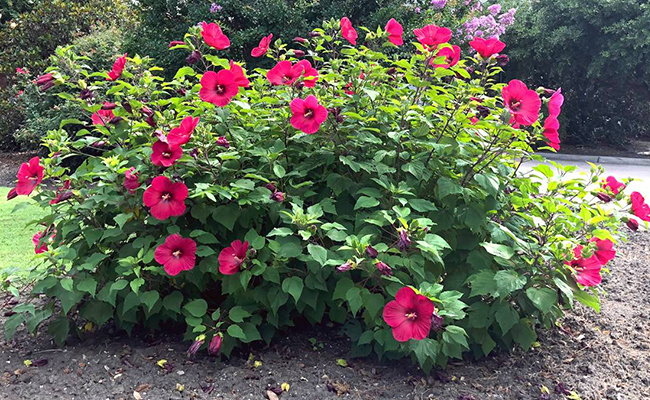How To Grow the Striking Hibiscus in your Garden?
Is your garden missing the large, conspicuous, trumpet-shaped flower of Hibiscus? Well, no more because here’s how you can grow the striking hibiscus plant in your garden. Before we start with the planting of the flower, let’s learn more about this gorgeous beauty.
Hibiscus plant is a tropical beauty with large, colourful flowers attracting eyeballs, hummingbirds, and butterflies, thus transforming your garden into a tropical paradise. Hibiscus is a genus of flowering plants in the Mallow family or Malvaceae. The showy flowers of Hibiscus are native to warm temperate climates, tropical and subtropical regions, and are less widely known as rose mallow, hardy hibiscus, rose of Sharon, and tropical hibiscus.

There are three types of Hibiscus varying from each other in care requirements, flowers produced, all of which are discussed below:
1. Tropical Hibiscus: Tropical Hibiscus plant produces sturdy-shape and vibrant coloured flowers that are more suitable for container plants and tropical gardens.
2. Hardy Perennial Hibiscus: The hardy perennial Hibiscus have large, disk-shaped flowers blooming in bold colours of red, yellow or pink. These flowers can be about 6-12 inches wide, and the perennial yellow, blue, red Hibiscus is called Swamp Mallow.
3. Hardy Shrub Hibiscus: Hardy shrub Hibiscus produces in abundance smaller flowers and grows into a larger shrub that doesn’t die in winters.
How To Grow Tropical Hibiscus
The Hibiscus plant of this type grows as a small shrub or as a woody tree with thick stems and glossy, dark forest green leaves. Blossoms of this plant are usually 3’’-6’’ in diameter and flowers in pretty colours of sunshine yellow, salmon pink, scarlet red, and even multicoloured.
- Climate: Hibiscus is intolerant to cold and freezing temperatures. Pots and containers with tropical Hibiscus plant should be brought indoors during cold weather.
- Soil: Rich and well-draining soil are good for tropical Hibiscus. Keep the soil moist but do not let the plant stand in water.
- Fertilizer: Feed the plant with balanced, organic, and liquid fertilizer regularly to encourage healthy growth.
To keep tropical Hibiscus over the winter season, bring it indoors before the night temperature falls. Keep the pot in a cool, bright spot. Reduce, but do not discontinue watering the plant. Your plant may lose leaves to accommodate the changing weather, so don’t panic. As the spring arrives, before moving the plant outdoors, prune the plant well, replace the top few inches of soil with fresh compost, feed it with organic fertilizer, and your lovely Hibiscus will grow in full glory all throughout the spring.

How To Grow Hardy Perennial Hibiscus
The herbaceous perennial Hibiscus produces dinner-plate-sized flowers which are usually flat and has a tissue paper-like texture. As compared to the tropical variety, the stems and leaves of this plant type are much softer, dull-green, and tender. Another distinguishing feature is that the plant dies completely to the ground in the winter and then sprouts anew in the spring.
- Climate: Choose a location for the perennial Hibiscus carefully. The location that receives sunlight is the preferred choice.
- Soil: Well-draining and fertile soil. The plant loves to remain moist during the summers. Therefore, it blooms naturally near ditches and swamps. In winters, make sure the roots are not soggy. Add mulch to lock moisture and to prevent damage from spring frosts.
- Fertilizer: It is a heavy feeder. Feed it with organic fertilizer with phosphorus to encourage growth.
In the fall or late winter, prune the stems of the Hardy Perennial Hibiscus to the ground level.

How To Grow Hardy Shrub Hibiscus
Last on the list is hardy shrub Hibiscus that are a must-have for hummingbirds and butterflies. With clusters of bloom smaller than its tropical cousins, the red, pink, white, lavender, and blue hibiscus of the hardy shrub that can grow up to 10 feet tall and wide brightens up the landscape.
- Climate: The upright, fairly dense, and coarse-textured flowers of Hardy Shrub Hibiscus grows best in temperatures that are neither too hot nor too cold.
- Soil: Rich and well-draining pot soil. Though the plant is adaptive to numerous growing conditions.
- Fertilizer: It has nutrient and average watering requirements.

Depending upon the climatic conditions of your area, and your preference, you can plant a Tropical Hibiscus, Hardy Perennial Hibiscus, or Hardy Shrub Hibiscus. You will need garden tools such as gardening gloves, hoe, shovel, spade, hand trowel, planters, secateurs, and you are good to go.
Planting
- Dig the hole in the planting site as deep as the hibiscus root ball and two-three times wide; If planting in a container, plant in a pot that drains well.
- Carefully place the bush in the planting hole or the pot
- Backfill the hole with an enriching soil and water the plant well.
- Eliminate any air pockets.
- Cover the base of the plant with one-inch layers of organic fertilizer such as earthworm casting, and water the soil to moisten the fertilizer.
- Protect the hibiscus plant from strong winds.
- Prune the cross, dead branches; spent flowers, and trim the plant so that all the stems are of the same length.
- Watch for insects and pests that can damage the plant.
Behold the sight of beautiful and colourful Hibiscus by nurturing and nourishing them correctly.















